To some people diving and photography is all about colorful reefs or getting the right angle of the huge wreck. Others spend hours and hours on a seemingly dead bottom, or diving in piles of human trash, and still come up with full memory cards and huge grins on their faces. What in heavens name are they so happy about? They could not possibly have found anything interesting under these conditions, could they?
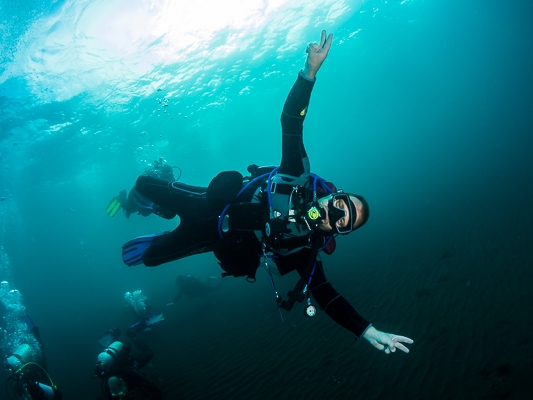
Ann Karin Matberg • OM-D E-M1 • M.ZUIKO DIGITAL ED 8mm 1:1.8 Fisheye
• PT-EP11 • PPO-EP02 • 2 x UFL-3
The name muck diving comes from the sediment that lies at the bottom of many dive sites – an often muddy or “mucky” environment. A muck dive can also take place on dead corals, discarded fishing equipment, or other man-made garbage. So, take a huge pile of garbage, add visibility that is usually less than the regular reef or wreck site – and you have a perfect muck diving site!
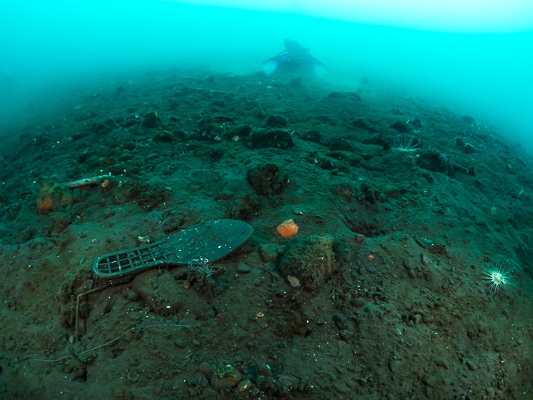
Ann Karin Matberg • OM-D E-M1 • M.ZUIKO DIGITAL ED 8mm 1:1.8 Fisheye
• PT-EP11 • PPO-EP02 • 2 x UFL-3
Muck diving might not sound like an intriguing activity, but submerging yourself into this macro world may lead to an addiction that you can’t get rid of and that you will always want to do again. It is a world full of surprises, strange and colorful animals – despite the first impression of a grey, dead bottom. Once you have discovered this world it might change your whole perspective of diving. So mount your macro lens, and get underwater with us!
To get the best shots you have to first find the motives ... This might not be so easy as a lot of the animals at a muck diving site are highly adapted and well camouflaged at first sight. But all you really need is a sharp eye and patience. Also, a dive light and a good spotter makes it a whole lot easier and is highly recommended until you learn where and what to look for. The light makes the colors stand out, and you will be surprised as to how colorful many of the animals in muck diving habitats really are.
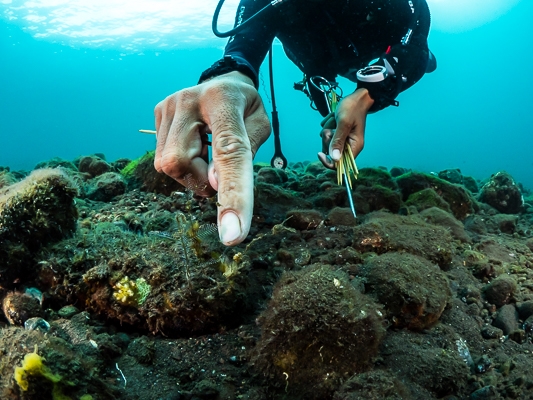
Ann Karin Matberg • OM-D E-M1 • M.ZUIKO DIGITAL ED 8mm 1:1.8 Fisheye
• PT-EP11 • PPO-EP02 • 2 x UFL-3
No matter what subject you are shooting, a good idea is to learn where they live. If you also know what they feed on, the chance that you will find exactly what you are looking for is much bigger than if you are just searching in the blind... Let’s take the nudibranch as an example – they often feed on hydroids or sponges. So, look for any hydroid or sponge – and you will probably find what you are looking for. Or you can do as I do: I hire a local guide and let them find the subjects for me. When they show me a nudi, I shoot both a close up picture of the nudi and also a picture from further away so I can recognize what habitat this specific nudi lives in. So the next time I see this type of sponge, I know that I have a certain possibility of finding the same type of nudi there.
Many animals are creatures of habit, and if you learn to recognize where they live or what they eat, you can start looking for this, and as soon as you find the habitat or food you can start looking for the animal.
So you have found your motive. And you want to get a good picture. How do you do that?
Think about the background.
Some of the animals blend very well into the background. If possible, try to find a specimen that has nothing behind it, so you can get a clear black background – this makes your motive stand out. If you have located one and it is in a tricky position, either look for another one, or wait until the one you have found moves into a better place. In some cases using a large aperture and focussing only on a small part of the animal can create pictures with a stunning colorful background.
Decide what you want in focus.
What do you want the picture to look like when you are done? If it is a nudi - do you want the whole nudi, or just parts of it in focus? Focus on the rhinophores is just as important in a nudi picture as focus on a fisheye is in a fish portrait. But again – never a rule without an exception! Maybe the mouth of a feeding nudi, or the sexual organs of mating nudies is what catches your eye. If it’s a tube worm – do you want to focus closely on the details of the “featherly” look, or do you want to capture the whole animal? If you are not sure: Try different apertures and spend 10-15 minutes to get different expressions.
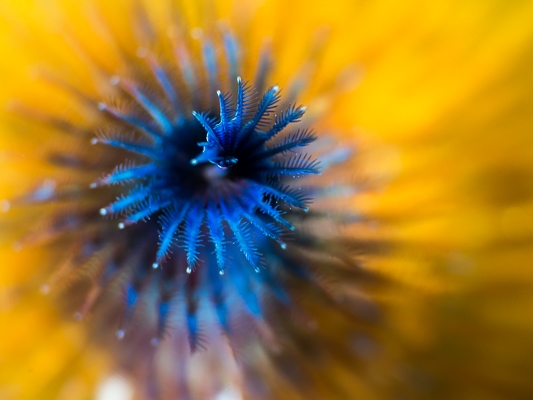
Blue and yellow tube worm
Ann Karin Matberg • OM-D E-M1 Mark II • M.ZUIKO DIGITAL ED 60mm 1:2.8 MACRO
• PT-EP14 • PPO-EP02 • 2 x UFL-3
Get “eye-contact”.
Taking a picture from the side or above is great for identification purposes, but often, it does not make the most striking pictures. If you can connect with your motive – so will your viewer.
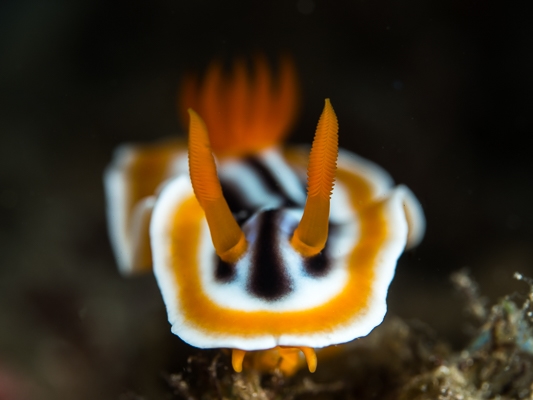
White nudibranch
Ann Karin Matberg • OM-D E-M1 Mark II • M.ZUIKO DIGITAL ED 60mm 1:2.8 MACRO
• PT-EP14 • PPO-EP03 • 2 x UFL-3
Try different flash positions.
A standard set up for macro is two flashes pulled slightly back from the camera port, turned slightly outwards (depending of distance to your subject – the closer to the subject, the more you need to pull your flashes in, and turn them inward to make the light hit), and positioned at “10 and 14 o’clock”. Varying the power settings of the flash (I always shoot manual) of the two strobes creates appealing shadows and creates depth in the picture. Backlighting of the subject might totally change the appearance of the subject!
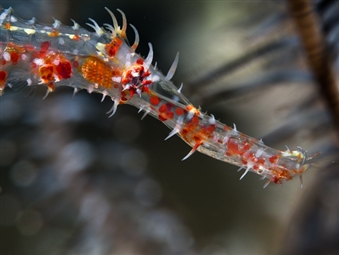

Juvenile ghost pipe fish with «standard» front lighting (left picture) and back lighting (right picture)
Ann Karin Matberg • OM-D E-M1 Mark II • M.ZUIKO DIGITAL ED 60mm 1:2.8 MACRO
• PT-EP14 • PPO-EP03 • 2 x UFL-3
There are some prime muck diving destinations in the world. Lembeh strait in Indonesia is one of them, Dauin in the Philippines is another, to mention just a few. They both basically have the same treats underwater. Lembeh has, in my opinion, a slightly bigger diversity of treasures, but Dauin has the advantage of extremely short boat rides (if you need to get in a boat at all), and much cleaner and more appealing waters. Blue ringed octopus, pygmy sea horses, hairy frogfish, flamboyant cuttlefish, hairy shrimps, Donald Duck shrimps, wonderpus and of course a wide variety of nudibranchs etc. – the list is endless of what you can meet during a dive.
So – diving in muck might not sound interesting – but the treasures you can find during your hunt makes it one of my absolute favorites. If you have not done this type of diving before don’t lose your hope if it seems like the bottom is dead, or you have ended up in a garbage deposit. Hire a good guide and let yourself drown in the mysterious world of muck diving!
Comments
Show more comments (0)